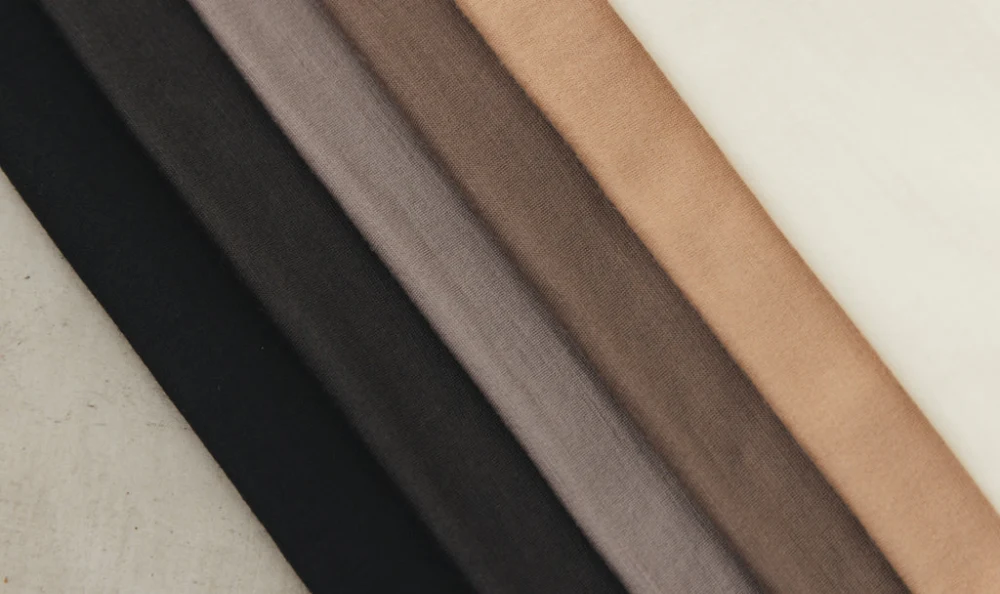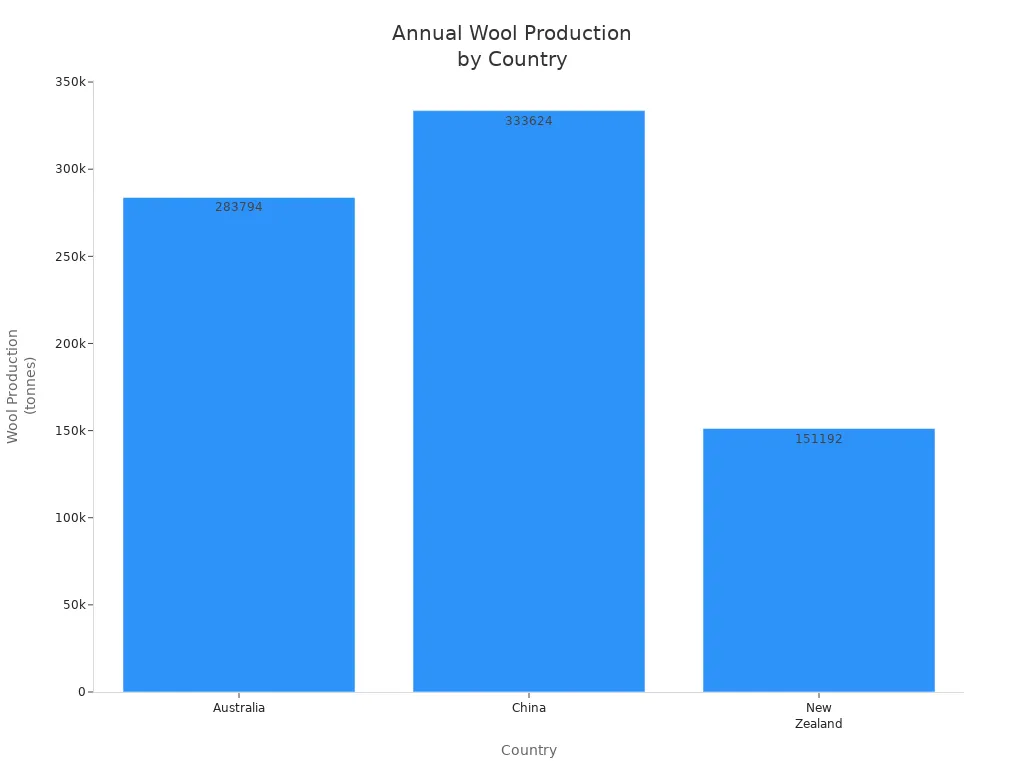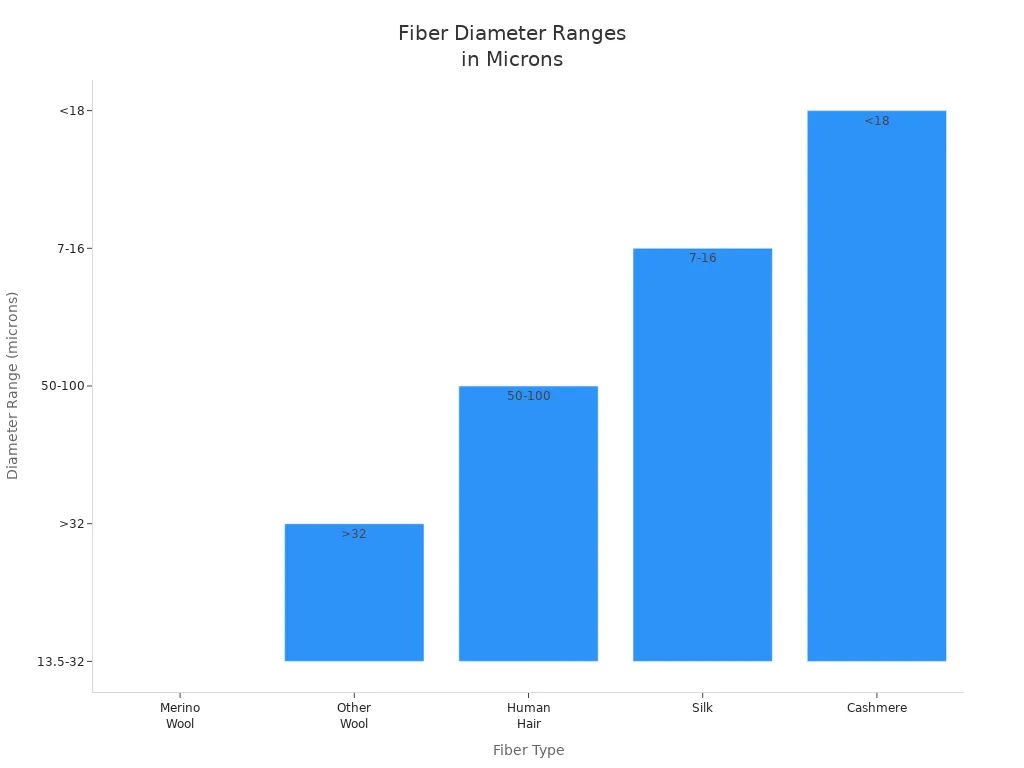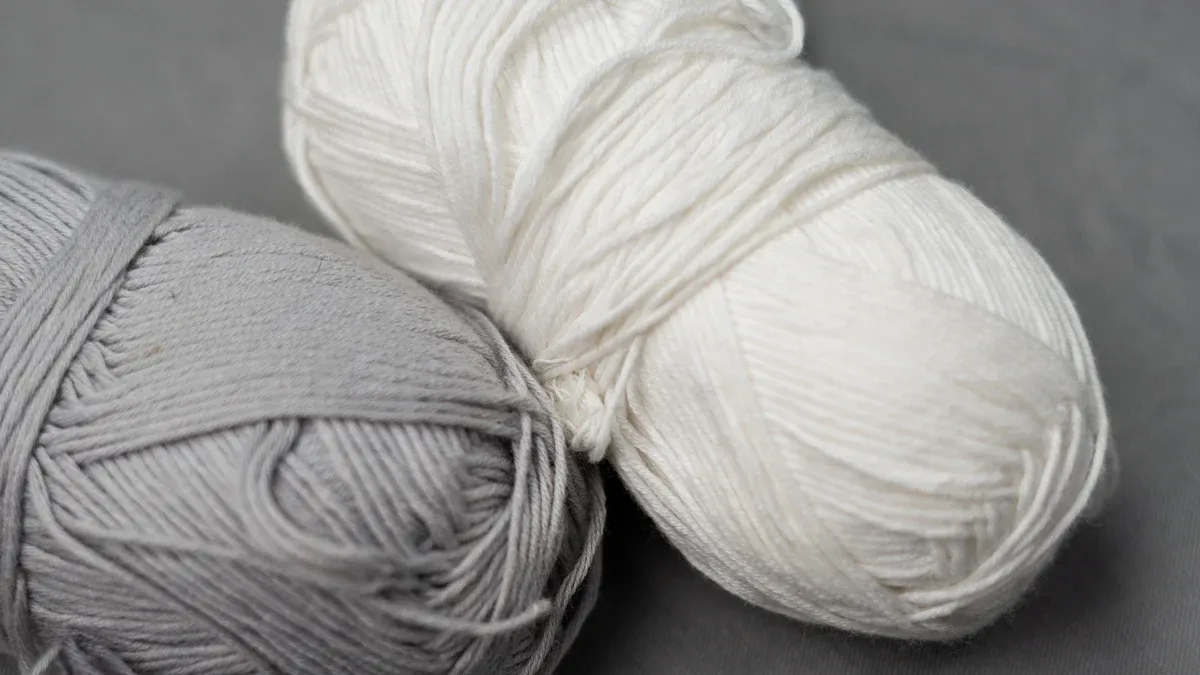
If you wonder what is merino wool fabric, you are not alone. This luxurious textile comes from Merino sheep and stands out in the global wool market for its exceptional softness and versatility.
Fanda Fabrics offers you high-quality merino wool fabric, perfect if you want comfort and reliable performance. Textile experts recommend merino wool to beginners for its hypoallergenic, wrinkle-resistant, and odor-resistant qualities.
You will enjoy a fabric that feels gentle on your skin and adapts to different needs, making it a smart choice for everyday wear and creative projects.
Key Takeaways
Merino wool comes from special sheep known for their soft, fine fibers that feel gentle on the skin and avoid itchiness.
This fabric naturally controls moisture, resists odors, and keeps you comfortable in many weather conditions.
Merino wool is durable, wrinkle-resistant, and easy to care for when washed gently and dried flat.
It is an eco-friendly choice because it is renewable, biodegradable, and often certified for ethical farming.
Fanda Fabrics offers a wide range of high-quality Merino wool fabrics suitable for clothing and home projects.
What is Merino Wool Fabric?

Merino Wool Origins
When you ask what is merino wool fabric, you start with the merino sheep. These sheep are famous for producing some of the softest and finest wool in the world. The story of merino wool began in Spain, where merino sheep were highly prized for their fine fleece. Over time, these sheep made their way to Australia.
Today, Australia leads the world in merino wool production, with about 345 million kilos of wool produced each year. Most of this wool comes from merino sheep, making Australia the top source for high-quality merino wool fabric. New Zealand and China also produce wool, but their sheep often have coarser fleece.
Did you know? About 90% of the world’s fine wool comes from Australian merino sheep, making it the gold standard for premium wool fabrics.
Here’s a quick look at the main wool-producing countries:
Country | Annual Wool Production (tonnes) | Notes on Merino Wool Production |
|---|---|---|
Australia | 283,794 | Largest producer of fine merino wool; 71.6 million sheep shorn (2021-2022) |
China | 333,624 | Largest overall wool producer, but with more crossbred sheep; imports merino wool from Australia |
New Zealand | 151,192 | Produces more crossbred wool, less fine than merino |
Spain | N/A | Historical origin of the merino sheep |

Fanda Fabrics sources its merino wool fabric from trusted suppliers in Australia and New Zealand. This ensures you get a product known for its softness, strength, and consistent quality.
Unique Qualities
You might wonder what makes merino wool fabric stand out from regular wool. The answer lies in the fiber itself. Merino wool comes from a unique breed of sheep with special genetics. These sheep produce wool with a much finer fiber diameter than other breeds.
Most merino wool fibers measure between 13.5 and 32 microns, with the finest under 18 microns. For comparison, regular wool fibers are usually much thicker—over 32 microns—and human hair ranges from 50 to 100 microns.
Fiber Type | Diameter Range (microns) | Notes |
|---|---|---|
Merino Wool | 13.5 – 32 | Fine merino under 18 microns for next-to-skin comfort |
Other Wool (general) | > 32 | Coarser fibers, less soft |
Human Hair | 50 – 100 | For scale comparison |
Silk | 7 – 16 | For scale comparison |
Cashmere | < 18 | For scale comparison |

This fine fiber structure gives merino wool fabric its signature softness and comfort. You can wear it directly against your skin without feeling itchy.
The fibers bend easily, so you avoid the prickly sensation that often comes with regular wool. Merino wool also has a longer staple length, which means the yarns are smoother and more durable.
Here are some key differences between merino wool and standard wool fabrics:
Merino wool feels soft and gentle, even for sensitive skin.
The fiber is lightweight, making it perfect for everything from T-shirts to winter coats.
Merino wool fabric manages moisture well, keeping you dry and comfortable.
It resists odors naturally, so you can wear it longer between washes.
The fiber is strong and resilient, so your garments last longer.
You get all these benefits because of the unique genetics of merino sheep and the careful breeding that has taken place over centuries. Environmental factors, like the climate in Australia and New Zealand, also help produce high-quality fleece. The result is a natural material that offers comfort, performance, and versatility.
Fanda Fabrics brings you merino wool fabric that showcases all these qualities. When you choose merino wool fabric from Fanda Fabrics, you invest in a textile that stands out for its softness, durability, and performance. Whether you are new to sewing or looking for premium materials, merino wool fabric gives you a reliable and luxurious option for your next project.
Merino Wool Fabric Properties
Softness and Comfort
When you touch merino wool fabric, you notice how soft it feels right away. This soft fabric comes from the fine fiber diameter of merino wool, which usually measures between 11.5 and 24 microns. Traditional wool fibers are much thicker, so they often feel itchy.
Scientific studies show that even within merino wool types, finer and more flexible fibers make the fabric softer and more comfortable. Medical research also finds that superfine merino wool can help people with sensitive skin, acting almost like a second skin.
You get a gentle, smooth texture that feels great against your body, making merino wool fabric a favorite for base layers and everyday wear.
Wool Type | Fiber Diameter (Microns) |
|---|---|
Merino Wool | 11.5 – 24 |
Traditional Wool | 25+ |
Cashmere | 14 – 19 |
Performance Benefits
You will appreciate the performance of merino wool fabric in many situations. The fiber structure gives you natural elasticity, so your clothes move with you and resist wrinkles. Merino wool fabric stands out for its breathability and moisture-wicking feature.
Laboratory tests show that it absorbs sweat, moves it away from your skin, and releases it as vapor. This keeps you dry and comfortable, even during activity. Merino wool also resists odors much better than polyester or cotton.
Studies show that it can stay fresh for days, making it perfect for travel or outdoor adventures. The fiber provides UV protection and holds up well over time, so your garments last longer. Fanda Fabrics offers merino wool fabric with these natural performance features, giving you reliable comfort and durability.
Sustainability
If you care about the environment, merino wool fabric is a smart choice. The fiber is biodegradable and comes from renewable sources. Many merino wool products carry certifications like the Responsible Wool Standard (RWS) and ZQ Certification, which focus on animal welfare, land management, and traceability.
Compared to synthetic fibers like polyester, merino wool has a much lower carbon footprint. Sustainable farming and careful sourcing help reduce environmental impact. Fanda Fabrics sources merino wool from trusted regions and supports eco-friendly practices, so you can feel good about your fabric choices.
How Merino Wool is Made?

Shearing and Sourcing
You start the journey of merino wool with shearing. Skilled workers gently shear Merino sheep, usually once a year, to collect the fleece. The timing of shearing matters. When you shear at the right time, you get stronger, cleaner wool with longer fibers.
This helps keep the sheep healthy and stress-free, which also improves the quality of the wool. Fanda Fabrics sources merino wool from Australia and New Zealand, where farmers use ethical shearing practices. These regions are famous for producing some of the world’s finest merino wool.
Tip: Clean, dry sheep and careful shearing help you get the best fleece for high-quality merino wool fabric.
Processing Steps
After shearing, you move to the next stage: cleaning and preparing the wool. The merino wool production process involves several steps to turn raw fleece into usable fiber:
Skirting: Workers remove the dirtiest parts and plant matter from the fleece.
Sorting and Grading: They sort the wool by color and quality to ensure consistency.
Scouring: The wool gets washed in hot water with mild detergent to remove dirt, grease, and lanolin.
Rinsing and Drying: Clean wool is rinsed and dried thoroughly.
Carding: Machines align and separate the fibers, making them smooth and ready for spinning.
Step | Purpose |
|---|---|
Skirting | Remove dirty/undesirable parts |
Sorting & Grading | Ensure quality and consistency |
Scouring | Clean wool, remove grease and dirt |
Carding | Align fibers for smoothness and strength |
These steps answer the question, “How is merino wool processed?” Each stage helps you get a cleaner, softer, and more consistent fiber, which is key for making premium merino wool fabric.
Spinning and Finishing
Once you have clean, carded wool, you spin it into yarn. Spinning twists the fibers together, giving the yarn strength and flexibility. The way you spin the wool affects the softness and durability of the final fabric.
After spinning, the yarn may be dyed using gentle, skin-friendly dyes. Next, you weave or knit the yarn into merino wool fabric, depending on the desired texture and use.
Finishing steps make a big difference. Fulling, decating, and steaming help lock the fibers together, prevent shrinkage, and boost softness. These techniques give merino wool fabric its smooth feel and long-lasting quality.
Fanda Fabrics uses advanced finishing methods to ensure every yard of fabric meets high standards for comfort and durability.
Note: Careful spinning and finishing are what set high-quality merino wool fabric apart from ordinary wool textiles.
Types and Uses
Types of Merino Wool Fabric
You can choose from several types of merino wool fabric, each with its weight and texture. The weight of the fabric affects how warm, soft, or breathable it feels. Here’s a quick guide to help you pick the right type for your project:
Weight Category | Fabric Types | Texture Description | Typical Uses |
|---|---|---|---|
Heavyweight | Cozy, Comfy, Durasoft | Dense, warm, durable; Cozy is fluffy and breathable; Comfy is flatter and denser; Durasoft is densest with shape retention | Winter gear, outerwear, bottoms, diaper covers |
Midweight | Jersey en Cozy, Drapier en Comfy | Balanced softness and structure; Jersey en Cozy is feltable with linen-like texture and stretch; Drapier en Comfy is flat-feeling, stretchy, and drapey | Sweaters, lighter garments, drapey clothing |
Lightweight | Jersey, Dreamweight | Thin, breathable, comfortable; Jersey is the lightest and most breathable; Dreamweight is soft, squishy, slightly heavier than Jersey | Base layers, dresses, tops, warm-weather clothing |
You will also find blends, such as merino wool mixed with nylon or spandex, which add stretch or extra durability. Fanda Fabrics offers a wide selection of these types, so you can find the perfect merino wool fabric for any season or style.
Apparel and Home Uses
You can use merino wool fabric for many different projects. In clothing, lightweight merino wool works well for base layers, T-shirts, and summer dresses. Midweight options are great for sweaters, cardigans, and everyday tops. Heavyweight merino wool keeps you warm in winter coats, jackets, and even outdoor gear.
Merino Wool Weight | Popular Uses in Apparel | Activity Examples | Key Features |
|---|---|---|---|
Lightweight | Warm weather wear, layering | Summer hiking, running, and cycling | Breathable, quick-drying, thin |
Midweight | Every day wear, mid-layer in winter | Spring/fall activities, skiing | Warmth without bulk, moisture management |
Heavyweight | Winter sports, cold-weather clothing | Skiing, snowboarding, camping | Thick, dense, maximum warmth |
You can also use merino wool fabric for home décor, such as cushion covers, throws, and blankets. Its softness and durability make it a favorite for both fashion and home projects.
Where to Buy Merino Wool Fabric?
You have many options when shopping for merino wool fabric, but not all stores offer the same selection or value. Here’s how Fanda Fabrics compares to other retailers:
Retailer | Selection Highlights | Pricing and Purchase Options | Notes on Quality and Availability |
|---|---|---|---|
Fanda Fabrics | Lightweight, heavyweight, blends, custom orders | Competitive pricing, wholesale, retail, and small batch | Wide selection, flexible formats, global shipping |
Mood Fabrics | Woven wool, various colors | Higher price, wholesale only | May require special care |
Riverside Fabrics | Knitted Merino, ethically sourced | Higher price, limited types | Limited color and type availability |
Woolen Mill Store | Durable, colorfast wool | Limited stock, some seconds | Colors may not match the screen display |
Fanda Fabrics stands out because you can order by the meter, request custom colors or blends, and even get small batch orders. You can shop directly on the Fanda Fabrics website for a broad range of merino wool fabric options. Whether you need fabric for a single project or bulk orders for your business, you will find flexible solutions and excellent customer support.
Care and Environmental Impact
Care Tips
Taking care of your Merino wool fabric helps you enjoy its comfort and performance for years. You can follow these simple steps to keep your garments looking and feeling their best:
Hand wash your Merino wool in cool water with a mild wool detergent. Gently soak and squeeze the fabric—never rub or wring.
Let it soak for up to 30 minutes, then rinse in clean, cool water until all soap is gone.
Press out extra water without twisting. Roll the garment in a towel to remove more moisture.
Lay flat to dry on a clean towel or drying rack. Avoid hanging, which can stretch the fabric.
Keep your Merino wool away from direct heat and sunlight while drying. Reshape it while damp for the best fit.
You can also machine wash on a gentle or wool cycle. Turn garments inside out, use a mesh laundry bag, and choose cold water with low spin. Always use a wool-specific detergent and skip fabric softeners. After washing, remove items promptly and reshape them before drying flat.
Tip: Fold your Merino wool garments for storage. Use breathable cotton bags and natural moth repellents like cedar blocks. Avoid plastic bags to prevent moisture buildup.
Common mistakes include hanging sweaters, using regular detergents, or ironing on high heat. You should always use the wool setting and a pressing cloth if ironing is needed. Air out your garments between wears to keep them fresh and reduce washing.
Environmental Benefits
Merino wool fabric stands out for its eco-friendly traits. You get a renewable resource because Merino sheep regrow their fleece every year. The fabric is 100% biodegradable, so it breaks down naturally and returns nutrients to the soil. Unlike synthetic fibers, Merino wool does not add microplastics to the environment.
Eco-friendly farming practices, such as regenerative grazing, help improve soil health and boost biodiversity. Merino wool production uses less energy than making synthetic fabrics. Its natural odor resistance means you wash it less often, saving water and energy.
You can trust Merino wool’s eco-friendly reputation by looking for third-party certifications. These labels show that your fabric meets strict standards for animal welfare, land management, and chemical use.
Certification Name | Description | Eco-friendly Verification Aspects |
|---|---|---|
Responsible Wool Standard (RWS) | Ensures wool comes from farms with progressive land and animal care practices. Prohibits mulesing and unnecessary animal suffering. | Guarantees animal welfare, sustainable land use, and ethical treatment of sheep. |
Global Organic Textile Standard (GOTS) | Certification for organic textiles covering the entire supply chain with social and environmental criteria. | Requires organic fiber content, prohibits harmful chemicals, ensures good working conditions, and reduces water and energy use. |
Fair Trade | Certification for raw materials from impoverished regions ensures social, economic, and environmental standards. | Promotes high social and environmental standards in production. |
Global Recycled Standard (GRS) | Certification for products with recycled content, covering the material chain and environmental management. | Encourages the use of recycled materials and reduces environmental harm. |
Choosing Merino wool fabric means you support eco-friendly options that are gentle on the planet and safe for your home.
Conclusion
Merino wool fabric gives you many benefits for your projects:
Soft, lightweight, and gentle on your skin
Excellent warmth and temperature control
Breathable, moisture-wicking, and odor-resistant
Durable, easy to care for, and eco-friendly
If you are new to Merino wool, try these tips:
Wash at low temperatures with wool detergent.
Turn garments inside out before washing.
Dry flat and avoid direct heat.
Fanda Fabrics offers high-quality Merino wool fabric for every need. Explore their range to start your next project with confidence!
FAQ
What makes Merino wool fabric different from regular wool?
You get a much softer and smoother feel with Merino wool. The fibers are finer and less itchy than regular wool. Merino wool also manages moisture better and resists odors, making it ideal for clothing you wear close to your skin.
Can you machine wash Merino wool fabric?
You can machine wash most Merino wool fabrics. Use a gentle or wool cycle with cold water. Always use a mild wool detergent. Turn your garment inside out and place it in a mesh bag for best results.
Is Merino wool fabric good for sensitive skin?
Yes, Merino wool works well for sensitive skin. The fine fibers feel soft and smooth, so you avoid itchiness. Many people with sensitive skin choose Merino wool for base layers and everyday wear.
Does Merino wool fabric stretch?
You will notice some natural stretch in Merino wool, especially in knit or jersey types. Blends with spandex or nylon add even more flexibility. This makes Merino wool comfortable for activewear and fitted garments.
Where can you buy high-quality Merino wool fabric?
You can shop for premium Merino wool fabric at Fanda Fabrics. You will find a wide range of weights, colors, and blends. Fanda Fabrics offers both retail and wholesale options, plus small batch customizations.
